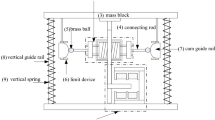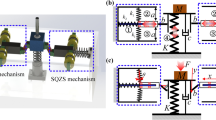Abstract
To improve the isolation ability of the existing equipment for low-frequency line spectrum, this paper presents an electromagnetic double-layer vibration isolation system (ED-VIS) for the first time. The negative and positive stiffness values of the ED-VIS are provided by the electromagnet and the linear spring, respectively. To better analyze the vibration isolation system designed in this paper, the dynamic model of the ED-VIS is established, and the effects of damping ratio, excitation force amplitude, and mass ratio on the force transmissibility feature of the isolator are analyzed. Then, the ED-VIS test bench is built, and the low-frequency vibration isolation capability of the ED-VIS is measured by a frequency sweep test. According to the sweep test results, a method to improve the low-frequency vibration isolation capability of the isolator is proposed. Finally, the reliability of the system in isolating low-frequency vibration is verified. The results show that compared with the equivalent linear vibration isolation system, ED-VIS is more sensitive to low-frequency vibration and has a lower initial vibration isolation frequency. Therefore, this paper designs the ED-VIS has better low-frequency vibration isolation performance.
Similar content being viewed by others
Abbreviations
- E-QZS :
-
Electromagnetic quasi-zero stiffness
- D-VIS :
-
Double-layer vibration isolation system
- ED-VIS :
-
Electromagnetic double vibration isolation system
- F :
-
Excitation amplitude
- w :
-
Mass ratio
- I :
-
Current
- ξ 1 :
-
Damping ratio
- Ω :
-
Excitation frequency
- K 1 :
-
Negative stiffness of QZS vibration isolator
References
Y. Qu et al., Structural vibration and acoustic radiation of coupled propeller-shafting and submarine hull system due to propeller forces, Journal of Sound and Vibration, 401 (2017) 76–93.
C. Liu et al., Recent advances in micro-vibration isolation, Mechanical Systems and Signal Processing, 56 (2015) 55–80.
Y. Tian et al., A study of a pendulum-like vibration isolator with quasi-zero-stiffness, Journal of Computational and Nonlinear Dynamics, 17(5) (2022) 051005.
Y. Y. Li et al., Study of the dynamics and application limitations of a class of double-layer high static and low dynamic stiffness vibration isolation systems, Journal of Vibration Engineering, 34(2) (2021) 364–371.
G. N. Zhu et al., A two degree of freedom stable quasi-zero stiffness prototype and its applications in aseismic engineering, Science China Technological Sciences, 63(3) (2020) 496–505.
X. Hu and C. Zhou, The effect of various damping on the isolation performance of quasi-zero-stiffness system, Mechanical Systems and Signal Processing, 171 (2022) 108944.
S. Dalela, P. S. Balaji and D. P. Jena, Design of a metastructure for vibration isolation with quasi-zero-stiffness characteristics using bistable curved beam, Nonlinear Dynamics, 108(3) (2022) 1931–1971.
G. N. Zhu et al., A two degree of freedom stable quasi-zero stiffness prototype and its applications in aseismic engineering, Science China Technological Sciences, 63(3) (2020) 496–505.
Y. L. Li and D. L. Xu, Force transmissibility of floating raft systems with quasi-zero-stiffness isolators, Journal of Vibration and Control, 24(16) (2018) 3608–3616.
X. Yu et al., Attractor migration control of quasi-zero-stiffness vibration isolation system with flexible foundation, Journal of Ship Mechanics, 23(7) (2019) 866–872.
Z. Lu et al., On the performance of a two-stage vibration isolation system which has geometrically nonlinear stiffness, Journal of Vibration and Acoustics, 136 (6) (2014).
G. Gatti, I. Kovacic and M. J. Brennan, On the response of a harmonically excited two degree-of-freedom system consisting of a linear and a nonlinear quasi-zero stiffness oscillator, Journal of Sound and Vibration, 329(10) (2010) 1823–1835.
A. R. Valeev, Vibration isolators for oil-and gas-transfer equipment with a low vibration frequency, Chemical and Petroleum Engineering, 47(5) (2011) 374–377.
S. Zuo et al., Design and testing of a parabolic cam-roller quasi-zero-stiffness vibration isolator, International Journal of Mechanical Sciences, 220 (2022) 107146.
M. Östberg, M. Coja and L. Kari, Dynamic stiffness of hollowed cylindrical rubber vibration isolators-The wave-guide solution, International Journal of Solids and Structures, 50(10) (2013) 1791–1811.
S. Kaul, Maxwell-voigt and maxwell ladder models for multi-degree-of-freedom elastomeric isolation systems, Journal of Vibration and Acoustics, 137 (2) (2015).
M. T. Wang et al., Design and analysis of electromagnetic quasi-zero stiffness vibration isolator, Journal of Vibration Engineering and Technologies, 11 (2023) 153–164.
A. C. M. de Queiroz, Mutual inductance and inductance calculations by Maxwell’s method, Home Page of Dr. Antonio Carlos M. De Queiroz (2005).
S. P. Parida and P. C. Jena, Free and forced vibration analysis of flyash/graphene filled laminated composite plates using higher order shear deformation theory, Proceedings of the Institution of Mechanical Engineers, Part C: Journal of Mechanical Engineering Science, 236(9) (2022) 4648–4659.
Z. C. Wang, S. L. Wang and J. H. Yu, Design and research of QZS vibration isolator with double link-spring-curved surface mechanism, Journal of Vibration and Shock, 40(11) (2021) 220–229.
X. Wang et al., Force transmissibility of a two-stage vibration isolation system with quasi-zero stiffness, Nonlinear Dynamics, 87(1) (2017) 633–646.
P. C. Jena, Identification of crack in SiC composite polymer beam using vibration signature, Materials Today: Proceedings, 5(9) (2018) 19693–19702.
P. C. Jena, D. R. Parhi and G. Pohit, Dynamic investigation of frp cracked beam using neural network technique, Journal of Vibration Engineering and Technologies, 7(6) (2019) 647–661.
Acknowledgments
The authors are grateful to the Natural Science Foundation of Hubei Province of China (2022CFB405).
Author information
Authors and Affiliations
Corresponding author
Additional information
Wang MengTong is a master’s student at the Naval University of Engineering. He is affiliated with the College of Power Engineering. His research interests include nonlinear vibration and control.
Liu ShuYong is an Associate Professor at the Naval University of Engineering. He is affiliated with the College of Power Engineering. His research interests include nonlinear vibration and control and chaotic weak fault signal processing.
Rights and permissions
About this article
Cite this article
Wang, M.T., Chai, K., Liu, S.Y. et al. Dynamic characteristics and experimental study of double layer vibration isolation system. J Mech Sci Technol 37, 1699–1709 (2023). https://doi.org/10.1007/s12206-023-0311-2
Received:
Revised:
Accepted:
Published:
Issue Date:
DOI: https://doi.org/10.1007/s12206-023-0311-2




